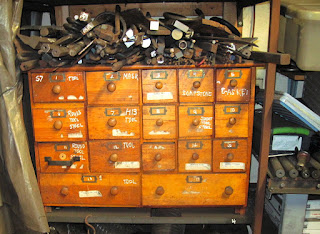At the time I was beginning blacksmithing, there was an enormous volume of antique agricultural equipment being scrapped and our area is primarily agricultural so I had easy pickings. I was also lucky to be a friend of the scrapyard owners and operators so a lot of the time they didn’t charge me anything. They charged for the type of material which was their high profit variety - massive and dense or didn't require being worked (disassembled, cut, crushed) before being loaded for hauling.
Mostly I picked up mild steel and wrought iron but from time to time built up a collection of steel suitable for tool making. I call this “Uncertain Alloy Scrap.” It didn’t come with a pedigree so I have learned the properties through irregular metallurgical experimentation. The spark test on a grinding wheel is sometimes useful. Mostly my testing involves seeing how quickly the piece draws heat - what is the terminal heat color - how hard is it to move with the hammer. After cooling it is tested for it air hardening suitability. If it doesn’t hold up to an air hardened edge test it is reheated and oil quenched. If it still won’t hold and edge, it isn’t tool steel for me. I never want to rely on a steel which needs water quenching.
So with practice I have found how to use pieces from this list of things I’ve collected:
Hay Rake rod
Harrow tines, spear type
John Deere Rotary Hoe tines
Hay bale spear spike
Deep cut plow discs
Caterpillar track pins
Road Grader blade
Jack Hammer Bits and Hex drill rod
Vehicle Axles, Tie rods and Coil and Leaf spring stock.
Trenching bits (excellent for hardy tools)
Lawnmower blades
Railroad rail clips and high carbon spikes.
I have hoped to find a Forklift blade to cut up for die stock but have never seen one in a scrap yard.
If I have a project I feel is really important I will use a known alloy like
S7, H13 and 4140. I don’t live in a large manufacturing area so it is hard to find known alloy tool steel drops. At blacksmith meetings I have picked up some at scrap prices but when I have to buy it from the online suppliers the expense really bites.
Sadly, the old scrapyard is now closed. But, my good fortune was to build up a big pile during the easy times. Almost all of my tool steel is shelved inside the shop now. The outdoor pile has dwindled over the last 15 years and the other day I noticed I could probably put all of it in the bed of my 1995 Dakota and haul it off in one load but what’s left will probably be enough for my needs.





























